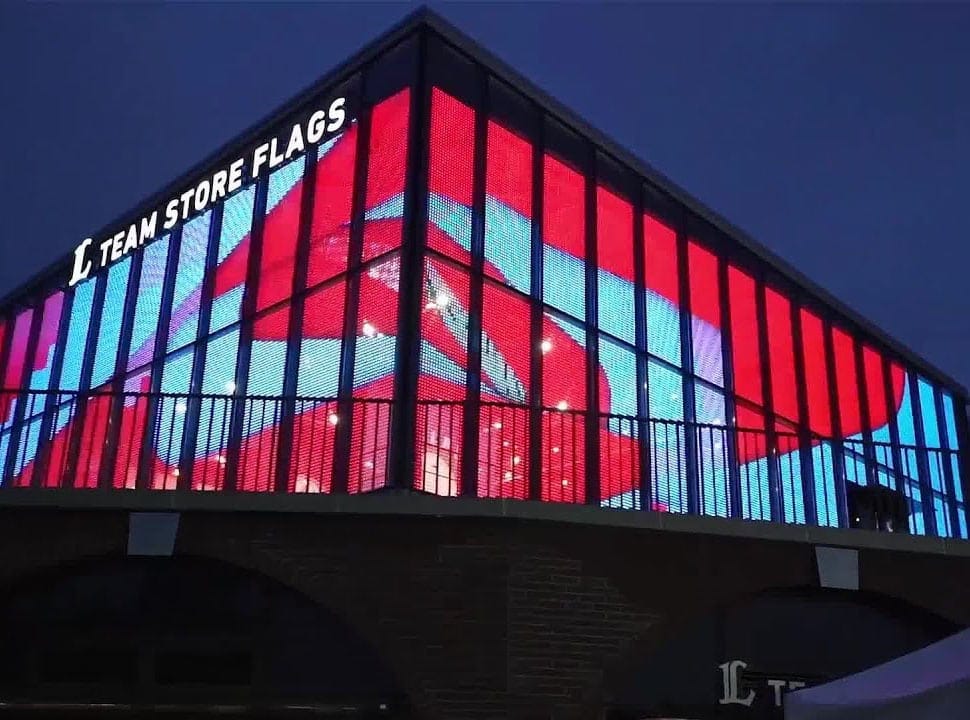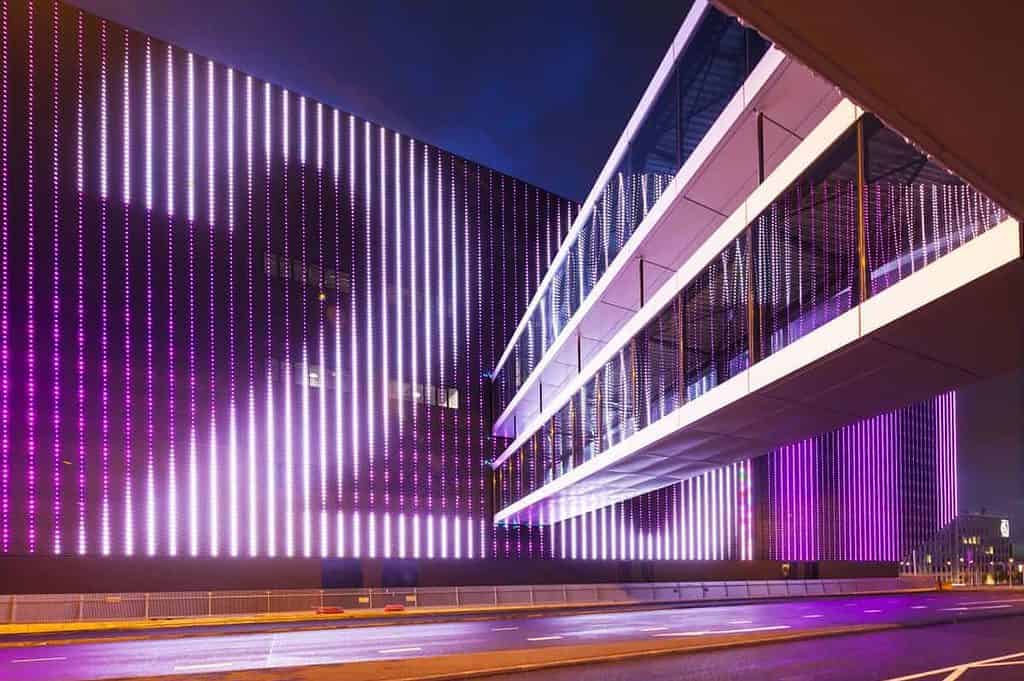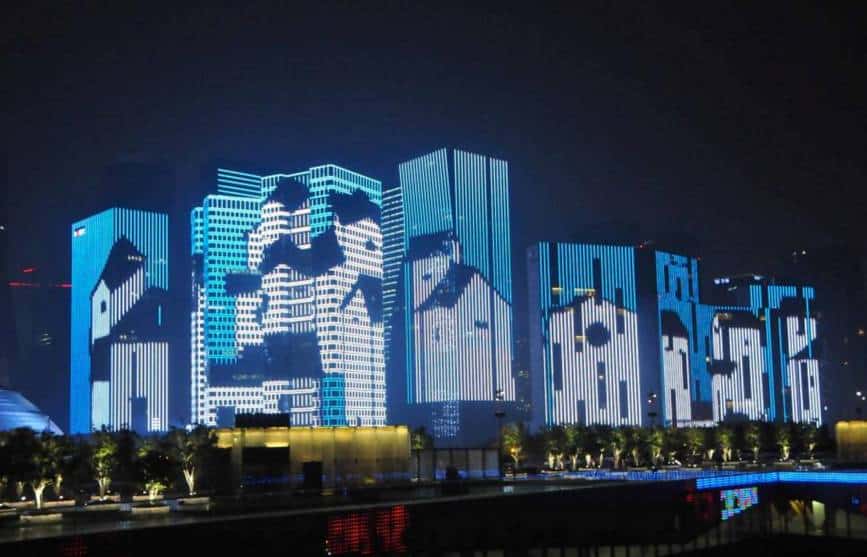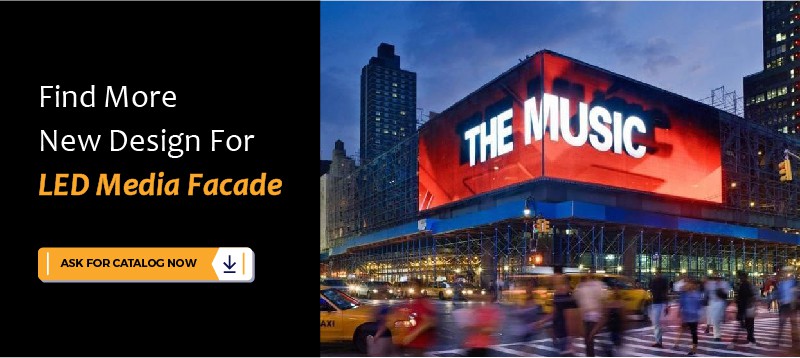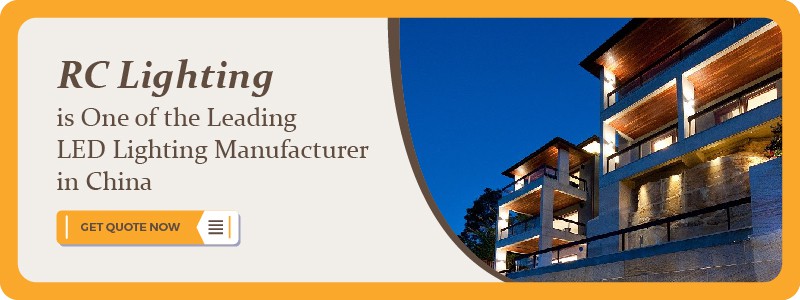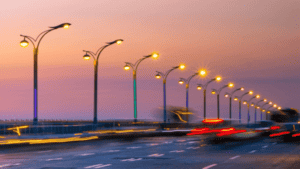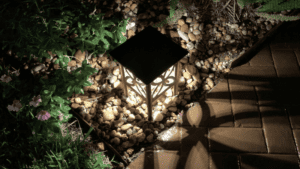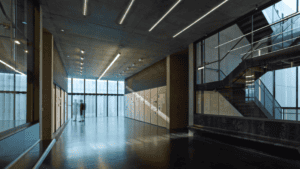What is Media Facade Lighting?
Media facade lighting comprises individual lights, typically LED lights, attached or integrated into a facade of a structure. The outer layer of a building or structure is called a facade. These lights are controllable, giving various colors and intensities to create dynamic designs.
This kind of lighting came on the scene because of the digital aspect of LED lights. When LED lights became popular in the 2000s, they gave designers an opportunity to change the building facades and use them as presentations rather than just boundaries separating the inside from the outside.
The lights you see are installed in the building’s exterior structure, such as balconies, boundaries, windows, etc.; it can all be regarded as facade lighting. Similarly, the lights that depict information or images are media facade lighting. It has become a way of turning any structure’s exterior into a billboard, ready for advertisement.
Often media facade lighting is also used to enhance the exterior look of a building and making into a work of art. Many artists have used these lights to display their artwork on facades.
Benefits of Installing Media Facade Lighting
Although media facade lighting is fairly new, its applications have made it pretty popular around the world. Here are some of the benefits that make it so sought-after:
Exterior Enhancement: Media facade lighting can instantly improve the external look of a building. It can breathe a new life into any boring or old structure, at least at night. Most architects are using these lights to give the external boundaries an artistic look that can also be customized or changed in the future.
Attention-Grabbing: With their changing colors and brightness, paired with the sheer size of the facade of some buildings, these lights can be quite some attention-grabbers. Passers-by and those using the premises can’t help but notice the illuminating facade of the building or any structure where they are installed.
Paid Advertisements: Since media facade lighting can be used to showcase images and graphics, they present a great opportunity for advertisers. These can turn any simple facade into a live billboard. It can add to the revenue of the building owners by allowing advertisements to run on the exterior of the building.
Conveying Information: Similar to the advertisement, the media can also be used to display information. It can be used for social impact messages or any information that needs to be communicated to the general public or commuters.
What are the Different Types of Media Facade Lighting?
As media facade lighting is still in its infancy, there aren’t that well-defined types. However, there are some variations:
Pixel Media Light
These lights work the same way as the pixels work on your screen, hence the name. These are small circular lights that are fully controllable LED lights. These can change color, temperature, and intensity. Their small size allows them to be integrated into building designs easily without becoming prominent in daylight.
Tube Lights
Similar to pixel media lights, these LED lights are in the shape of tubes. This type of media facade was first used by RealU for Potsdamer Platz in Berlin, where they used ring-shaped LED tubes and bars as pixels for the glass facade of the building.
Solar Media Lights
Even though media facade lights use LED lights, so they are energy-efficient, some designers are exploring green media facade lighting that uses solar energy for power. The Green Pix media facade in China is the first of its kind that uses photovoltaic modules.
Transparent Profiles
This futuristic lighting forms a transparent mesh that acts as a skin for the building facade and turns into a media display in the evening. As a result, it doesn’t interfere with the actual facade and disappears when the lights are off.
Where is Media Facade Lighting Used?
Media facade lighting is commonly used in buildings, especially in urban centers with large foot traffic or vehicular traffic around. In the future, you may also see this kind of lighting on other important structures such as bridges, empty walls, and monuments.
Some popular structures around the world that use media facade lighting include Burj Khalifa in Dubai, Kunsthaus Graz in Austria, and Illuma in Singapore.
How to Choose Media Facade Lighting?
Choosing media facade lighting depends on a number of factors:
Design of the Building
The most important thing to consider before installing media facade lighting on any building is the design of the building itself. That will determine the kind of lighting you should use for the most part.
While most buildings with media facade lighting these days incorporate it in their basic design, this lighting can also be installed on existing building structures. You need to consider the size and shape of the facade, and more importantly, the materials used in it.
Display Design
The second thing to consider is what you’re going to display on the facade using these lights. This will determine the kind of lights you need and how many of them you need. There’s a lot of flexibility in these lights, but still, the display design matters a lot.
Purpose
Another deciding factor is the purpose behind the media facade lighting. Are you installing these lights for decorative purposes or marketing?
Cost
Installing media facade lighting on a building facade can be a costly undertaking. So it’s vital to take into account the total costs for the project.
How to Install Media Facade Lighting?
The installation process for media facade lighting is something only a professional can do. It’s typically design and architecture firms that complete such installations with engineers and technicians on board.
Here’s a simplified installation process for such lights:
Step 1: Determine the installation locations. These lights can cover the entire exterior of the building or just a certain position, as per the design of the facade.
Step 2: Choose the right type of media light to support the design.
Step 3: Create electrical connections for the individual lights.
Step 4: Install the lights as per the instructions from the manufacturer.
Step 5: Use the central controller to check different displays on the lights.
Why Choose Media Facade Lighting from RC Lighting?
RC Lighting is a leading manufacturer of media facade lighting from China, producing safety-certified facade pixel media LED lights. These lights are produced in our dust-free facility that ensures high quality and long-lasting performance.
Powered by OSRAM LED lights, these facade lights are highly energy-efficient. With the control in your hand, our media lights allow you to capture your wildest imaginations when it comes to building facades. All our pixel media lights are cost-effective and have a three-year warranty.
Conclusion
Media facade lighting is one of the hottest trends in the architecture and urban design world. The Berlin-based studio RealU may have started the idea, but it has become a worldwide phenomenon. With both practical and aesthetical applications, these facade lightings have a long way to go in modern architecture.

